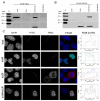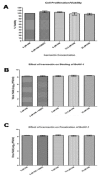Ivermectin Inhibits Bovine Herpesvirus 1 DNA Polymerase Nuclear Import and Interferes with Viral Replication
- PMID: 32183205
- PMCID: PMC7143239
- DOI: 10.3390/microorganisms8030409
Ivermectin Inhibits Bovine Herpesvirus 1 DNA Polymerase Nuclear Import and Interferes with Viral Replication
Abstract
Bovine herpesvirus1 (BoHV-1) is a major bovine pathogen. Despite several vaccines being available to prevent viral infection, outbreaks are frequent and cause important economic consequences worldwide. The development of new antiviral drugs is therefore highly desirable. In this context, viral genome replication represents a potential target for therapeutic intervention. BoHV-1 genome is a dsDNA molecule whose replication takes place in the nuclei of infected cells and is mediated by a viral encoded DNA polymerase holoenzyme. Here, we studied the physical interaction and subcellular localization of BoHV-1 DNA polymerase subunits in cells for the first time. By means of co-immunoprecipitation and confocal laser scanning microscopy (CLSM) experiments, we could show that the processivity factor of the DNA polymerase pUL42 is capable of being autonomously transported into the nucleus, whereas the catalytic subunit pUL30 is not. Accordingly, a putative classic NLS (cNLS) was identified on pUL42 but not on pUL30. Importantly, both proteins could interact in the absence of other viral proteins and their co-expression resulted in accumulation of UL30 to the cell nucleus. Treatment of cells with Ivermectin, an anti-parasitic drug which has been recently identified as an inhibitor of importin α/β-dependent nuclear transport, reduced UL42 nuclear import and specifically reduced BoHV-1 replication in a dose-dependent manner, while virus attachment and entry into cells were not affected. Therefore, this study provides a new option of antiviral therapy for BoHV-1 infection with Ivermectin.
Keywords: BoHV-1; DNA polymerase holoenzyme; Ivermectin; NLS; antiviral; nucleocytoplasmic shuttling; pUL30; pUL42.
Conflict of interest statement
The authors declare no conflict of interest.
Figures





Similar articles
-
An importin alpha/beta-recognized bipartite nuclear localization signal mediates targeting of the human herpes simplex virus type 1 DNA polymerase catalytic subunit pUL30 to the nucleus.Biochemistry. 2007 Aug 14;46(32):9155-63. doi: 10.1021/bi7002394. Epub 2007 Jul 20. Biochemistry. 2007. PMID: 17640102
-
Cooperative nuclear import of duck plague virus DNA polymerase subunits: pUL42 NLS Enhances pUL30 nuclear import and viral replication, with VP22 as a compensatory factor.Vet Microbiol. 2025 Aug;307:110603. doi: 10.1016/j.vetmic.2025.110603. Epub 2025 Jun 13. Vet Microbiol. 2025. PMID: 40526994
-
The Pseudorabies Virus DNA Polymerase Accessory Subunit UL42 Directs Nuclear Transport of the Holoenzyme.Front Microbiol. 2016 Feb 15;7:124. doi: 10.3389/fmicb.2016.00124. eCollection 2016. Front Microbiol. 2016. PMID: 26913023 Free PMC article.
-
Bovine Herpesvirus 1 Counteracts Immune Responses and Immune-Surveillance to Enhance Pathogenesis and Virus Transmission.Front Immunol. 2019 May 7;10:1008. doi: 10.3389/fimmu.2019.01008. eCollection 2019. Front Immunol. 2019. PMID: 31134079 Free PMC article. Review.
-
The latency related gene of bovine herpesvirus types 1 and 5 and its modulation of cellular processes.Arch Virol. 2016 Dec;161(12):3299-3308. doi: 10.1007/s00705-016-3067-5. Epub 2016 Sep 22. Arch Virol. 2016. PMID: 27659677 Review.
Cited by
-
Evaluation of Antiviral Activity of Ivermectin against Infectious Bovine Rhinotracheitis Virus in Rabbit Model.Animals (Basel). 2023 Oct 10;13(20):3164. doi: 10.3390/ani13203164. Animals (Basel). 2023. PMID: 37893888 Free PMC article.
-
Ivermectin: a systematic review from antiviral effects to COVID-19 complementary regimen.J Antibiot (Tokyo). 2020 Sep;73(9):593-602. doi: 10.1038/s41429-020-0336-z. Epub 2020 Jun 12. J Antibiot (Tokyo). 2020. PMID: 32533071 Free PMC article.
-
Ivermectin: A Multifaceted Drug With a Potential Beyond Anti-parasitic Therapy.Cureus. 2024 Mar 12;16(3):e56025. doi: 10.7759/cureus.56025. eCollection 2024 Mar. Cureus. 2024. PMID: 38606261 Free PMC article. Review.
-
Analysis of the Function of LncRNA-MSTRG.16919.1 in BHV-1-Infected Bovine Kidney Subculture Cells by Transcriptome Sequencing.Viruses. 2022 Sep 22;14(10):2104. doi: 10.3390/v14102104. Viruses. 2022. PMID: 36298658 Free PMC article.
-
A cellular and molecular biology-based update for ivermectin against COVID-19: is it effective or non-effective?Inflammopharmacology. 2023 Feb;31(1):21-35. doi: 10.1007/s10787-022-01129-1. Epub 2023 Jan 7. Inflammopharmacology. 2023. PMID: 36609716 Free PMC article. Review.
References
-
- Workman A., Zhu L., Keel B.N., Smith T.P.L., Jones C. The Wnt Signaling Pathway Is Differentially Expressed during the Bovine Herpesvirus 1 Latency-Reactivation Cycle: Evidence That Two Protein Kinases Associated with Neuronal Survival, Akt3 and BMPR2, Are Expressed at Higher Levels during Latency. J. Virol. 2018;92:e01937-17. doi: 10.1128/JVI.01937-17. - DOI - PMC - PubMed
Grants and funding
LinkOut - more resources
Full Text Sources

